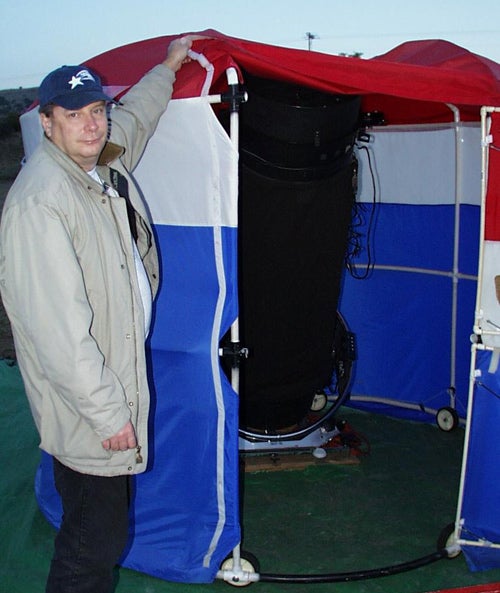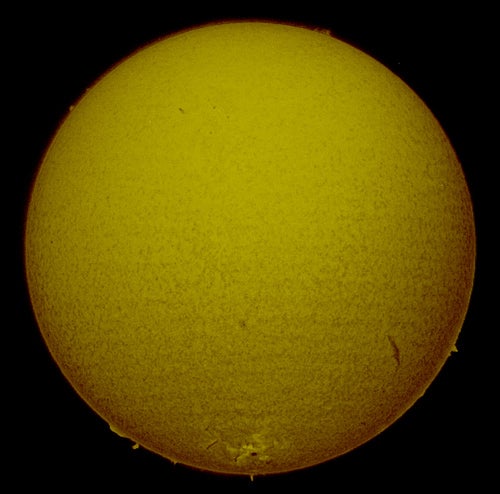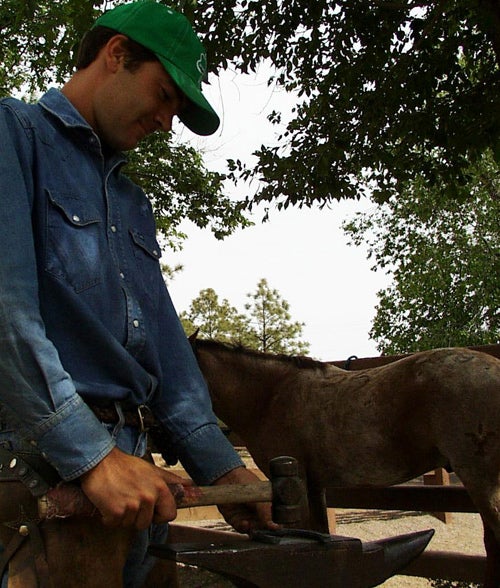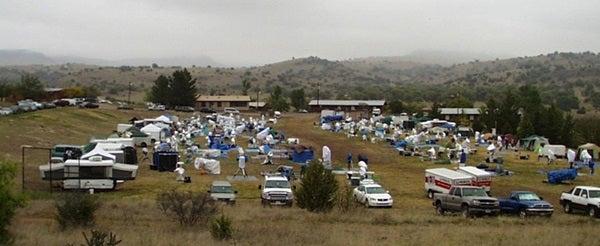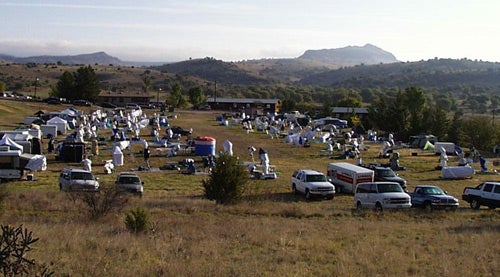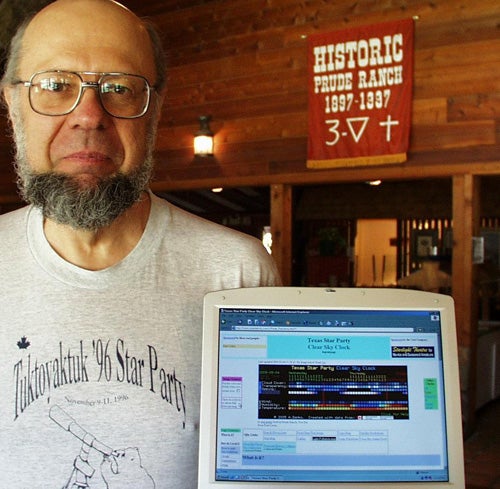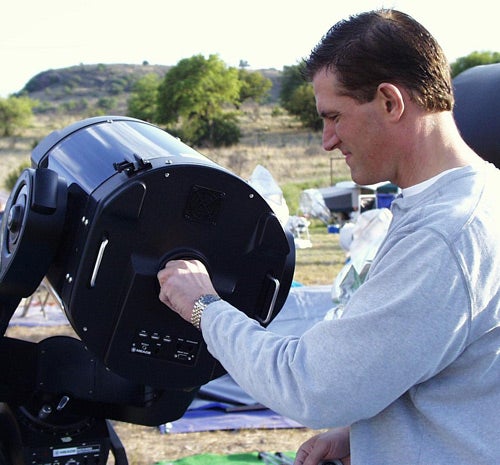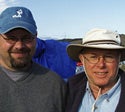Dealing with disappointment
There are certain character traits necessary for skygazers. These traits go beyond talent and ability. It’s nice to know the sky well enough to become your own go-to telescope. Likewise, each of us covets an eagle eye. Perhaps the most important astronomical trait has nothing to do with the sky itself: An astronomer must be able to deal with disappointment.
After all, how many meteor showers, eclipses, and occultations have you missed because of extenuating circumstances during your observing career? You learn to take the good with the bad, to see things optimistically.
This year’s Texas Star Party has separated the “glass half full” people from those who might regard it as half empty. Blame it on El Niño, the astronomy gods, or the person who just bought a new 6-inch triplet apochromatic — no offense to Jeff Barton. In the end, TSP 2005 has yielded only a few opportunities for observing. Oh, there were a few hours of scope time awarded to the “storm riders” in the early morning hours Friday. And we had a couple of bad transparency, bad seeing nights. But I, and other astrophotgraphers, will be coming away from this normally grand week without one single astronomical image.
Devastated? No, I’m not. Sure, my agenda was to take a new image each night, one that was perhaps deemed good enough to grace the pages of Astronomy magazine’s image gallery. And make no mistake about it — everybody comes to such a multi-day star party with an astronomy agenda. That will have to wait.
However, thankfully, those precious vacation days are not wasted. The good outweighs the bad — watching a friend win a nice door prize, dining with friends, showing some TSP “newbies” the ropes, and having the chance to demonstrate the hobby to a group of West Texas teens and their enthusiastic, knowledgeable teacher.
If you sense a theme, then you’ve probably figured it out. To me, the Texas Star Party is much more about astronomers, less about astronomy. People disappoint me much less than poor weather. — Jay Ballauer
Joe’s Dome and the great asteroid chase
Joe Gafford is a TSP veteran. He has missed only one event since 1991. His red, white, and blue portable dome is a standout. But what got him noticed this year was the “great asteroid chase” — and the one that nearly got away.
“I went to the Minor Planet Center site, where they list the new discoveries, and downloaded the coordinates of one that was located right in the middle of last night’s big sucker hole, so I chased it and got several sightings and coordinates. I filed the data via the wireless network from the upper field,” he said.
That’s the first such report from here since the 1998 TSP. And it very nearly didn’t happen.
I asked about his observatory.
“It’s my second, the larger one. I got this JMI NGT 18 [Jim’s Mobile Incorporated 18-inch Newtonian], so I needed a bigger one,” he explained.
I mentioned it looked big enough to sleep in.
Gafford is a member of the Denver Astronomical Society, whose Rocky Mountain dark-sky site is roughly double the elevation here in the Davis Mountains. But wind and cold aren’t the only demons that haunt amateur astronomers.
“I heard something pop, something electronic, last night. I think the guiding chip is fried, so I may be out of action until I get the controller back to Jim’s Mobile, Inc.,” he said.
But by Friday, he’d isolated a bad connection and resoldered it. This allowed him to control the scope manually and at least download the data he needed to confirm the asteroid’s orbit.
“I do this a lot,” he said, “so I knew if I could get the electronics up enough to grab several images I’d be okay.” He got five in all.
The observatory is stitched lightweight tent fabric stretched over a PVC-pipe frame. This secured with hem loops and Velcro. It is very tidy. I asked him if he’d had it sewn by a tent maker.
“No, it’s all my work. I saw an ad for used Singer sewing machines, from the schools you know. So I figured they’d have heavier gears. That reminds me, I’ve only got one needle left,” he added.
The design features wheels along the lower PVC frame tubes. The whole affair is simple to turn, with the big split-ring NGT scope sitting under the dome shutter flap. A key part of the scope’s design that allows it to be used in tight quarters is the rotating secondary housing.
“That makes it much easier,” he agreed. “It is very good, too. I don’t have to recollimate after rotating it. Very convenient,” he added.
The idea for the dome came from Astronomy magazine, he said. “I saw an ad in the back part of the magazine, where the smaller ads and classifieds were years ago. It was a similar design but a lot bigger. I thought, I could do that. I’ll bet it wouldn’t be half bad.”
That’s an understatement. His setup was arguably the most-photographed on the field.
— Jeff Barton
The Union Jack flew over Texas this week as Keith and Jan Venables of the Society for Popular Astronomy “crossed the pond” from Surrey, England, to hang out with the locals. While Keith is a TSP veteran, it was Jan’s second trip. Keith addressed the attendees today to describe his antidote for aperture fever: A year-long project to build an 18-inch Serrier Truss tube Newtonian, custom fork mount, and fiberglass dome observatory.
“We live on the approach to Heathrow, so my design goals were a little different,” he explained: “It [the telescope] had to transportable so that we could take it all with us at some point to a darker location, it had to be aesthetically-pleasing, it had to be as large as I could manage, and it had to be such that I could do all of it, from design through fabrication, myself.”
He found willing volunteers along the way as his project became known, but it was virtually a complete do-it-yourself (DIY) project.
“I learned, for example, that all it takes to cut even inch-thick aluminum plates is patience and oil,” he said. “I just used hand tools and power tools you can find in any garage. The dome is constructed of fiberglass and resin panels on an octagon of wooden panel sides, surrounding a pier that is a couple of tons of concrete below ground.”
The dome is software-controlled, via assistance from John Brewster of ASCOM to ensure software upgradability and standardization.
“The scope took most of the time. Once I had the mold box for the dome panels, the observatory work went very quickly,” he explained. “The scope itself is an 18-inch, f/4.4 Newtonian that weighs about 50 kilos [110 pounds]. The mount is about 250 kilos [550 pounds]. I’ve learned you need the extra weight in the mount.”
How does it perform? Keith ended his presentation with a photo made from the best 1,000 of 10,000 frames of an avi file from a ToUCam Pro. It was Mars at closest approach in 2003. He then showed the corresponding Hubble Space Telescope and drew an appreciative round of applause. It is a real performer. The drive has a pointing accuracy of about 10″ and slew rates up to 5° per second.
“I can rotate the dome with one finger. I used roller bearings and that was the trick. I’ve seen all kinds of tricks with other designers, including golf balls in tracks as bearings, and they tend to jam up,” he said. “This one is very smooth. In fact, the dome-rotation motors are two truck windshield wiper motors and small gearboxes.”
More information on this do-it-yourself project is available from Venables’ web site. — Jeff Barton
Vendors to the rescue
The Texas Star Party is known for its swap meet and vendor area. Often, a vendor rescues an attendee’s star-party experience with a necessary specialty item.
This year, wet weather ensured vendors sold dew removers and scope covers very quickly. Although I brought three scope covers, I purchased two more. Yes, the dew is that heavy.
“I just saw Al Nagler of Tele Vue in the vendor building. He personally repaired my StarBeam for me. I should have had him autograph it,” said Phil Jones, of Frisco, Texas. I agreed. Not only is Nagler a popular figure here, but he also routinely bails people out. “It’s nice to have those guys up there with their products,” I added.
At the time, I was working on a new SolarMax 90 that Bill Dean of Coronado Instruments had just delivered to the Three Rivers Foundation for the Arts & Sciences (3RF) here. I was having a little trouble removing a diagonal from the drawtube.
Pling!
“What was that?” Jones asked.
We looked down. My brand-new chromed brass lock screw rested in the dust. I had been using it for leverage while twisting the diagonal to free it from the drawtube. I guess I don’t know my own strength.
I walked uphill to the vendor building to find Bill Dean of Coronado Instruments. That was pretty easy — he was set up in his customer area, on the lawn behind the building. It looked like a forest of PST’s and SolarMax scopes.
“This can’t be good,” he joked, seeing what I had in my palm.
“Do you have any spare thumbscrews?”
A grin tugged at the corners of Bill’s mouth, but his customer face won out and he nodded, “Let me see.”
Turns out he had a complete replacement focuser barrel. All we needed was a strap wrench.
“Doesn’t it just slide out when you loosen the screw?” I asked.
“Well, you see we LockTite these in there to make them secure,” he replied.
I was too sunburned for the blush to show. Of course they’re made that way — we did specify we wanted the focuser for CCD images.
Bill went off in search of a fix and I wandered over to his scopes. If you get the chance, you want to see one of the calcium line filters. Wow. That is a very different view of the Sun. When I got back down to the 3RF area I found Bill and Phil had repaired the drawtube clamp. Phil was sliding his Nikon up into the draw tube to photograph prominences. Bill watched for a moment and then said, “I want to see the photos when you’re done!” He waved, and went back to his less clumsy customers.
The scope-makers’ fraternity is small, and their margins are not on a par with the computer/electronics industry where I’ve worked for 25 years. However, I’ve found them to be unusually customer-focused and nowhere has this proved to be more true than here in the field at the TSP. — Jeff Barton
It’s a working ranch, after all
Astronomers don’t arrive at the TSP on horseback, but they often set out on trail rides once they get there.
I found farrier Alex Muratori of Alpine, Texas, at work on a saddle pony on Wednesday.
“The rocky terrain can be a problem for these horses, so we check them often,” he said. The ranch has a couple of on-site wranglers, and they call him often to ensure the horses are always in good shape.
A passing group of amateurs from Houston overheard the comment and asked whether visitors to the ranch bring their own mounts (equine mounts, not equatorial).
“I don’t recall any of you astronomers doing that, but they sponsor groups here from time to time who do,” he said. “You wouldn’t believe how many working horses there are in this area. And their owners practically lavish them with care.”
As the clang of his hammer punctuated his explanations, he shaped shoes for the pony while astro-tourists clicked snapshots of the work. I asked him how long it takes to learn the trade.
I watched him shape the horses hooves after removing the worn shoes, then shape and fit the new shoes and tack them into place. The whole process took about 10 minutes per hoof. He’s obviously had the practice.
How often is this required in such rocky terrain?
“You’d be surprised. The worst part is stone bruises. The wranglers here are careful to stick to the trails, to avoid that. They call me out fairly often, but it’s usually just worn shoes. With a group like you folks, a few hundred at a time, the rides are real popular, so I get out here a couple of times during the week,” he explained.
Some of the ponies are from Mexico. “Especially for the work horses on ranches in the area, you want the ponies from Mexico. Down in the flats, they don’t even need shoes. Up here in the mountains, though, we usually shoe them. They are real tough little hombres, though. Very healthy,” he said.
“Is it genetic?” a Houston astronomer asked.
“Yeah, it’s selective breeding. They’re very good at that. You find the good ones and make sure they pass that down the line.” — Jeff Barton
Scanning the scope field
As darkness approaches, the skies begin to clear and the forecast is the most promising so far this week. Off come the tarps!
I scanned the northern and most populous scope field. I realize that I’m standing in “Takahashi alley.” These skygazers were observing through various sizes of exquisite Takahashi refractors, ranging from 3- to 6-inch apertures.
Further down the field, big Dobs reign supreme, some measuring 36 inches, accessed by matching 20-foot ladders. These larger brethren dwarf the 18-inch Obsession Dob I brought to the star party.
Schmidt-Cassegrains and Maks are peppered throughout the field, as well as a few gorgeous homemade instruments brought by amateur telescope makers. None of these compares to the beautifully designed, yellow and black 17-inch Dob positioned in the middle of the field. It’s enough to make anybody here stop dead in his or her tracks.
Her? Yes, there are a few women attending the star party, and the diversity is certainly welcome. Still, men and big glass dominate the Texas Star Party. — Jay Ballauer
Poor weather hampers views
Overcast and misty weather has covered the first few days of the 2005 TSP. The forecast calls for partly cloudy skies through Thursday. Having the TSP Clear Sky Clock has helped many observers prepare.
We have viewed the Sun through patches of blue off and on during the day. Last night the first hour after sunset provided decent views — many observers targeted Jupiter and Saturn. Following the nighttime presentation, we were greeted by white lights on the scope field and realized there would be no further observing tonight. — Jeff Barton
Attila in the lion’s den — a meteorologist among astronomers
Under lowering, misty skies, as he leaves the TSP’s office, Attila Danko looks up. Most astronomers do that. As the developer of the Clear Sky Clocks (CSC), however, he has a more vested interest than most.
CSC is an on-line resource for astronomers. The site forecasts the visibility of more than 2,300 North American locations during a 48-hour window. By using CSC, skygazers can avoid the disappointment of an observing session ruined by suddenly cloudy skies. A Hungarian now based in Ottawa, Danko is the wizard behind CSC.
A veteran of the TSP, Danko has come to expect questions about the weather and the “Clocks.”
“We’re working on the improvements,” says Danko.
One CSC enhancement will be an expansion of the meteorological data processed by Allan Rahill’s innovative software at the Canadian Meteorological Center (CMC), especially in the area of forecasting seeing. “About 18 months ago, we had the problem where the clocks had gotten so popular that, as Allan had predicted, we began to run into the CMC’s policy of not releasing ‘specialty’ forecasts,” explains Danko.
Danko urged Clock users to e-mail Rahill asking that the data remain available. “Allan took a couple thousand of these to his supervisor,” reports Danko.
It worked — maybe too well. The CMC decided to offer the data as a standard product. The downside: a near-term deadline to update the software to its final state.
That clock is ticking.
“Now I have to rework the programs that generate the Clock web sites from CMC’s data, so it remains possible to continue updating the Clocks,” Danko says.
Rahill’s data-processing algorithms, based on what he learned from the observations, make the Clocks possible. Now, according to Danko, the Clocks be even more useful.
“Even knowledgeable amateur astronomers often confuse tube currents with seeing effects. Peter Ceravolo and Roland Christen once tested two different scopes that weren’t even 100 feet apart and found the seeing dramatically different. The larger Newtonian had significant tube currents, and that was it,” he explains.
The seeing forecasts consider wind speeds and other factors at all altitudes — not just where the Jet Stream appears. “It’s the lower couple hundred feet that make the difference, outside the Jet. If you plot altitude versus seeing effects, you get a bump in the curve right where the Jet is located, but down here [near the scope] you get a shape like this [Danko draws a long, inclined ramp] showing how much the lower atmosphere right over your scope contributes,” says Danko.
His next hurdle is convincing United States-based meteorologists to do the daily supercomputing runs needed to add Hawaii and other geographic regions to the CSC’s coverage. “Fully 70 percent of the Clocks are in the U.S.,” explains Danko. Because data processing is performed by CMC, Danko is gathering support for having U.S.-based resources shoulder some of the burden.
To check your observing location, visit the CSC web site. — Jeff Barton
While Sunday is a time of respite from the long road trips to the Ft. Davis area, Monday serves as the first serious night of observing for many TSP participants. When cloudy skies prevail, as they did this Monday night, the attention turns to observing equipment.
As for many other amateur astronomers, much of my fun in the hobby is viewing and talking about astronomy gear, especially telescopes and cameras. And the “drool factor” is high among most TSP attendees — giant scopes up to 36 inches are commonplace here.
The intrigue during this otherwise boring, misty, overcast Monday night occurred when renowned astrophotographer and Meade aficionado Jason Ware arrived with a surprise. I found Ware setting up a 16-inch Meade LX200 on its spectacularly large field tripod. But what caught my attention was the scope next to it. Peeping out from a scope guard were some sleek, black tripod legs familiar to me only in pictures on the Meade web site. This isn’t your father’s LX200, or any other LX scope for that matter! It is a new RCX-400 scope that Meade markets as possessing advanced Ritchey-Chrétien (RC) design.
“I’ve had the scope for about a month,” explained Ware, who has observed and imaged with the scope before TSP.
Expecting questions on the scope’s RC-like performance, the instrument guru was right on cue. “It shows a little bit of field curvature on my 6303 [CCD] chip, but it’s nowhere near as aberrant as an SCT [Schmidt-Cassegrain telescope].” Then Ware offered, “I suspect Meade will produce an optional field flattener for it. Other makers are producing such devices for their RCs as well.”
The 6303 chip is not small, but if Jason Ware says it does a nice job of providing pinpoint stars on these, except for the very corners, then I would say Meade has a successful design on its hands — RC or not.
“I will say this,” Ware proclaimed as he held up a new monster Meade Series 5000 eyepiece, “I’m getting pinpoint stars to the very edges with this baby!”
Of course, that brought up a series of questions regarding the visual capabilities of the new scope, to which Ware summarily replied, “You’d anticipate a lessening of contrast due to the large central obstruction, I guess. I’m not thinking it’s a problem.”
As the mist relented, Ware ended his impromptu discussion session and unleashed the beautiful 12-inch scope.
I’m sure that questions continued long after my exit, my own appetite for “scope talk” sated. Then again, TSP offers many opportunities for scope talk. Hmm, I wonder if Ware ever finished setting up the LX200? — Jay Ballauer

